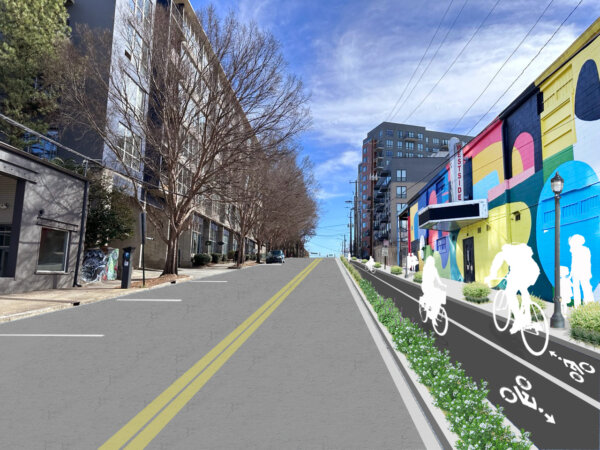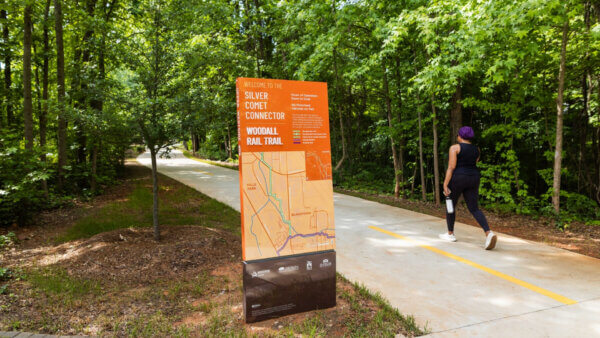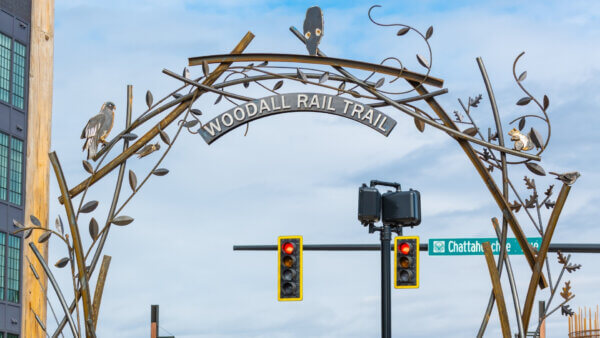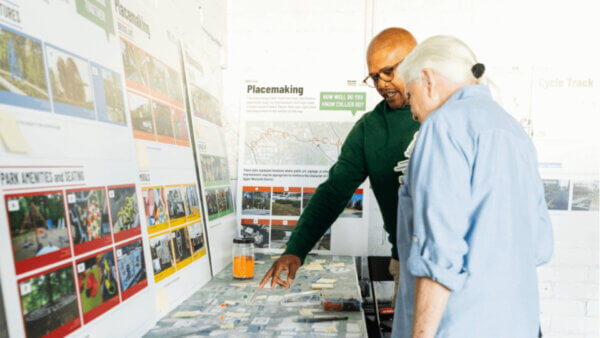From GeorgiaTrend.com:
Creative Collaboration
North Fulton County’s CIDs tackle transit, walkability, safety and more.
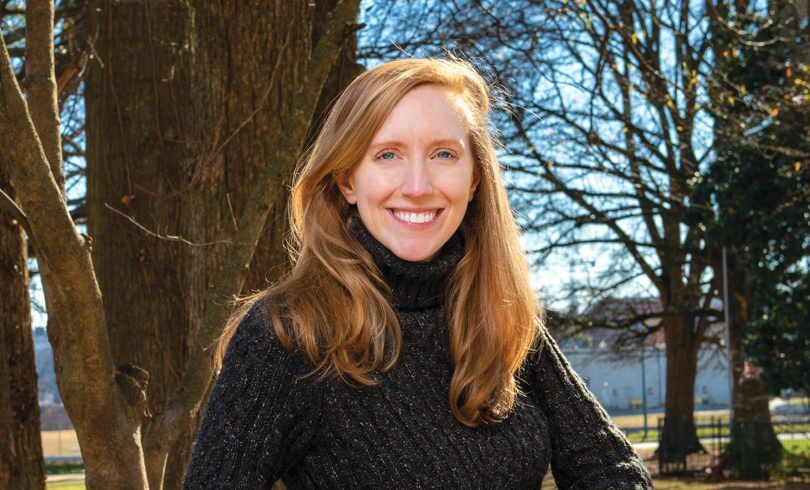
Credit: daemonpictures.com
Over the past 12 months, North Fulton County’s community improvement districts (CIDs) have accomplished some amazing things. They’ve revamped MARTA stations, turning cold concrete into vibrant, colorful spaces. They’ve overhauled major thoroughfares, making them safer for pedestrians and bicyclists. And they’ve given people more choices about how to get around inside their districts, whether by foot, bicycle or, yes, scooter.
Though each CID is unique in its makeup, budget and priorities, they all share one commonality: “CIDs are the mechanism by which commercial property owners are able to have a seat at the table when discussions on infrastructure are taking place,” says Ann Hanlon, executive director of the Perimeter CIDs, which includes the Fulton Perimeter CID and the Central (DeKalb) Perimeter CID.
A CID is a self-taxing district of commercial property owners. They’re formed to give the owners a collective voice and a mechanism to address issues in their district, like traffic congestion, walkability, safety and intangibles like sense of place and personality.
“It’s just really important to have somebody that’s paying attention on the street every day with the ability to make things happen, that knows how to get things done,” says Kevin Green, president and CEO of the Midtown Alliance, sister organization for the Midtown Improvement District. “And that’s what CIDs do.”
Transit Expansions
Nearly one year ago, state legislators passed HB 930, a bill that created a new, 13-county regional transit authority called the ATL, which could dramatically change the transit landscape across Metro Atlanta.
For the North Fulton CID, which runs along Ga. 400 through portions of Roswell, Alpharetta and Milton, transit expansion is a top priority. Last June, then-Gov. Nathan Deal allocated $100 million for four bus rapid transit interchanges inside the CID, stretching along Ga. 400 from I-285 to the Forsyth County line. The interchanges will tie into the Georgia Department of Transportation’s planned Express Lanes project, which will add 16 miles of toll lanes from I-285 north.
While transit projects are prohibitively expensive for CIDs to take on themselves, the North Fulton CID will still play an important role in this project’s rollout and success, says Executive Director and state Sen. Brandon Beach.
“Where the CID can help is to facilitate,” he says, “from an education standpoint to help the transit entities educate employers and the public on the benefits of public transportation.”
And, as Hanlon from the neighboring Perimeter CIDs notes, transit is no longer just about getting people in and around busy markets. It’s now a deciding factor in where businesses land.
“Transit has become a very glamorous issue, especially in the world of economic development, because gone are the days when only transit professionals are talking about transit,” she says. “Now, you’ve got CEOs and executives at companies making decisions about where they locate their companies based on transit.”
State Farm, Mercedes- Benz, NCR and Anthem have all announced major moves to transit-friendly sites around Metro Atlanta for one simple reason: talent.
“CEOs realize that to attract the talent you want to attract, you have to offer them transit options,” says Beach. The CID is also focusing on last-mile connectivity to help commuters get from transit to their final destinations, as well as the “21st century infrastructure,” says Beach, of fiber and small cell technology.
Walkable Districts
The Midtown Improvement District’s 1.2 square miles contain 16 percent of the city’s jobs, says Green, and 25 percent of the city’s tech jobs. It’s also a popular residential choice, with about 2,800 residential units currently under construction. In such a densely populated area, it shouldn’t be a huge surprise that walkability is one of its CID’s main focuses.
“If you get the walkability right, everything else follows,” Green says. “A lot of our emphasis is on ensuring that Midtown is a place that you want to experience on foot, where there’s convenient choices for getting around, and where there’s interesting things to see and do.”
So, how do you get people walking more? You start by giving them safe, efficient intersections and sidewalks, as part of “complete streets.” Green’s team uses intersection counters to gauge the number of pedestrians and bicyclists traveling along its busiest corridors, and they’ve installed a “pedestrian scramble” at bustling Tech Square, which allows pedestrians at the intersection of 5th and Spring streets to cross safely in any direction – including diagonally – while the light is red.
In the Buckhead CID, streetscape projects are another tactic to boost foot traffic – as well as other modes of transportation. Several of its major roads are also being reworked as “complete streets,” with dedicated bike lanes, spacious sidewalks and safer intersections to better balance vehicle traffic with foot, bicycle and other traffic.
A revamped East Paces Ferry Road will debut this year, with enhanced pedestrian and bicycle facilities and better connectivity to transit and the PATH400 multiuse trail. Piedmont Road, Lenox Road and Peachtree Road will also receive street-scape enhancements, says Buckhead CID Executive Director Jim Durrett.
“We are concentrating pretty heavily on how we can create safe opportunities for people to get around the district without having to be in an automobile,” he says. “That’s what people are asking for.”
Durrett also sees community engagement and planning for PATH400 enhancements to begin this year. “We want to be able to provide the neighborhoods around the district with access to PATH400 and then ultimately to the Atlanta BeltLine,” he says.
Building Community
Greenspace can be hard to come by throughout these districts, which is why these CIDs have gotten creative in how they find and develop it.
One of the Upper Westside CID’s first projects, for instance, was cleaning out the public land next to the Hemphill Reservoir at the corner of 17th Street and Northside Drive. It’s a project that’s been on the drawing board for nearly a decade, made possible by the formation of the CID in the summer of 2016.
Working with neighborhood grassroots organizations, city of Atlanta council members and the Department of Watershed Management, the Upper Westside CID was able to clear 4.5 acres of overgrown brush, making way for public greenspace at the corner lot.
“That’s brand-new greenspace for our area, which is so under-parked,” says Elizabeth Hollister, the Upper Westside CID’s executive director. “It’s got a fantastic view of the skyline, and it is open for business.”
Hollister plans to outfit the park with community-driven amenities – possibly outdoor games, fitness areas and an overlook for the skyline view. And she sees pocket parks joining the Hemphill park to create a connected network of greenspace across the district.
In the Buckhead CID, planning continues on a park over Ga. 400. The CID is in the middle of about $600,000 of pre-engineering work, says Durrett, for a 9-acre greenspace capping Ga. 400 and the Buckhead MARTA station. The CID will be launching a fundraising campaign soon to pay for the park’s engineering and final design.
“We do not have a significant gathering place. We do not have a Piedmont Park,” he says. “In an area like this where the public realm is entirely sidewalks, it’s very difficult for the community to be able to come together. That’s why this park … is so important.”
Though not parks per se, the Midtown Improvement District has also launched projects to give its residents and commuters fun places to gather. It’s created community badminton courts through leased land and small equipment investments, and it’s re-envisioned existing infrastructure, like MARTA station plazas, from concrete, utilitarian spaces to vibrant reflections of the district’s artistic slant.
At the Midtown MARTA station, Green’s team partnered with MARTA to install “astro mounds” of astro turf, commission bright murals on the once-bare walls and add seating to foster connections among commuters. It wasn’t a hugely expensive project, says Green, but its impact was immediate, in stark contrast to the years-long capital projects CIDs often take on.
These types of “quick-win” projects are important tools for CIDs, letting them make visible change quickly and cost-effectively. In the Perimeter CIDs, landscaping projects are relatively quick ways to revamp the district’s look. And in younger CIDs like the Upper Westside CID, they’re good ways to gain momentum while longer-term projects develop.
“There are some small investments that can be made that would have a huge benefit to the district – things like sidewalk repairs and adding flashing beacons to crosswalks,” says Hollister. “These are things that are perfect opportunities for the CID to supplement what the government is already trying to work on.”
The Importance of Planning
North Fulton’s CIDs also spend significant time talking with their commercial property owners to figure out how to best invest their budgets.
Hanlon’s team at the Perimeter CIDs completed an exhaustive master planning process last year. Hanlon met with dozens of market leaders – mayors from Sandy Springs, Dunwoody and Brookhaven, as well as city managers, public works officials, county commissioners and council members – to distill their priorities and opinions on what improvements were most needed. The result is the PCIDs Consolidated Plan, a list of 37 projects the CIDs will advance over the next 10 years, driven by the community itself.
“I’m really excited that we have a crystal-clear roadmap for the future here at our organization, and that really is going to help decide how we invest,” Hanlon says. “Our boards really wanted a clear way to invest their dollars in the future, and I think that our new master plan and our project list clearly illustrates it.”
Each project in the plan falls into one of three categories: access, mobility and sense of place. They will tackle how people get in and out of the CIDs, how people get around inside the CIDs and how the CIDs want their districts to look and feel. And master-planned work has already begun: The board approved funding two major corridor studies along Abernathy Road and Johnson Ferry Road, as well as funding for landscaping and traffic officers during peak congestion periods.
A similar process is getting started at the Upper Westside CID, where more than a dozen plans, some more than a decade old, touch a portion of the district. “This kind of patchwork version of planning is, first of all, difficult for our board to pick projects to pursue,” Hollister says. Also, the area has morphed from industrial to more mixed use, bringing in more residents and businesses. And some areas of the district have never been touched by a plan, aside from citywide plans. The solution: a comprehensive master plan, which the CID will begin this year.
“This will not be our CID’s plan,” clarifies Hollister. “It will be the plan of our community that will, I think, give us a playbook and a list of priorities that’s been publicly vetted that we can then pursue for additional funding.”
Forming the Upper Westside CID was an important step for commercial property owners around Howell Mill Road, Marietta Street, Huff Road, Chattahoochee Avenue and Collier Road. “In our case, we touch 10 neighborhoods, three different council districts and three different neighborhood planning units,” Hollister says. “There wasn’t any group that was particularly thinking about how we can make our corridors work. It was much more localized: ‘How do we make these three blocks work together?’”
Now, the CID can think about both sides of the road at the same time, Hollister says, giving a unified voice to the area and a funding mechanism to create cohesive change. “That was critical to us,” she says.
As the young CID prepares to create the first comprehensive master plan its district has ever seen, Hanlon, leading a pair of CIDs almost 20 years its senior, reflects on the strengths of the self-taxing districts.
“CIDs can be very, very powerful tools, and we are able to be innovative and nimble,” she says. “The way that we function now is going to continue to evolve over the next five to 10 years as things change. … I’m really, really excited to see how CIDs can be out there on that bleeding edge of innovation for our districts.”
See the original article, hosted on the GeorgiaTrend.com website.

